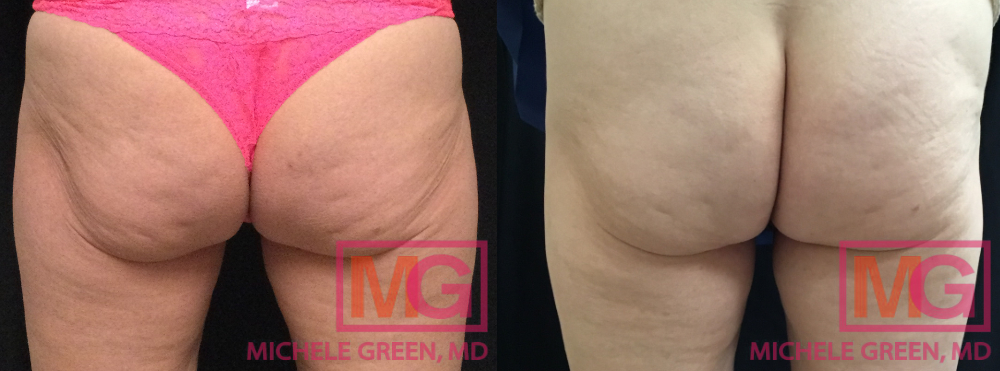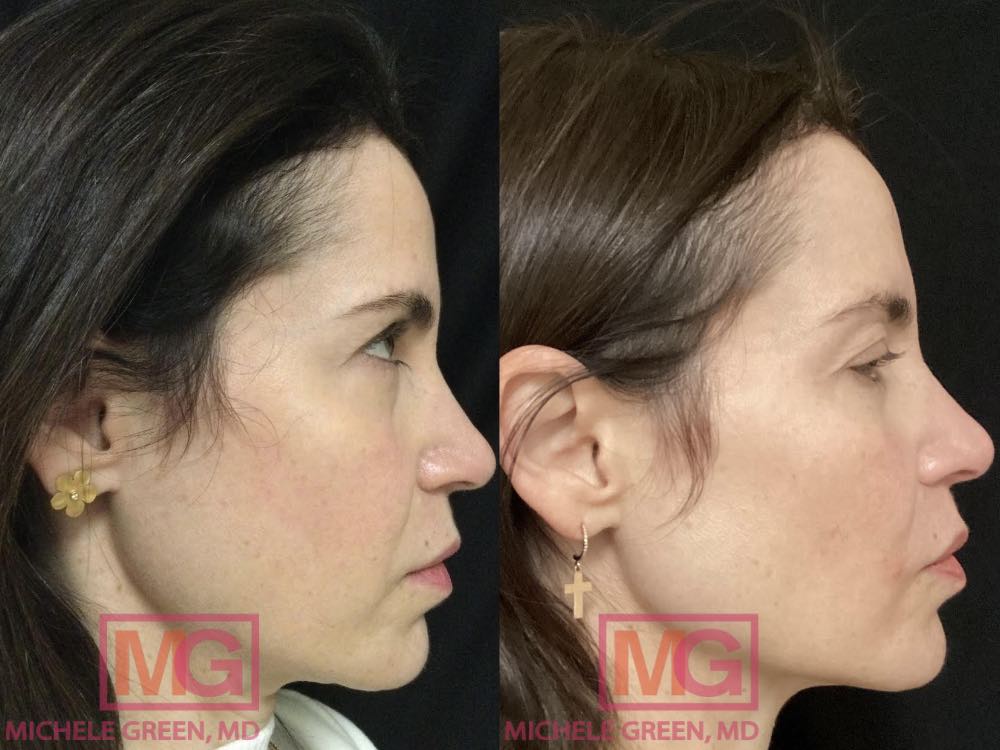Ultherapy or Thermage for Skin Tightening NYC
As we age, the production of the structural proteins collagen and elastin begins to decrease, leading to increased skin laxity, which emphasizes the appearance of fine lines, wrinkles, and cellulite. Increased skin laxity and loose skin can affect many areas of the body, with decreased collagen production contributing to signs of aging on the lower face, along the jawline, including the appearance of jowls, around the eyes, on the neck, decolletage, arms, legs, abdomen, buttocks, and thighs. Loose skin on the face and body causes many patients to look for an anti-aging skin-tightening treatment. Many patients hold the false belief that a surgical facelift performed by a plastic surgeon is required to erase these signs of aging. However, two types of non-invasive skin-tightening procedures act as a non-surgical facelift to reduce skin laxity for tighter, more youthful-looking skin: Thermage and Ultherapy, which are available at board-certified dermatologist Dr. Michele Green’s New York City dermatology office.
Thermage and Ultherapy treatments are FDA-approved skin tightening procedures that provide patients with smooth, firm, evenly textured skin in a single treatment. These non-invasive procedures provide similar results but differ in the type of energy used: Thermage uses radiofrequency energy to heat the dermal layers of the skin, boosting new collagen production over time. Ultherapy, on the other hand, uses micro-focused ultrasound technology to penetrate the deeper layers of the dermis to generate new collagen production “from the inside out.” Both Thermage and Ultherapy provide patients with long-lasting results without the need for any downtime or risk of significant side effects, making the procedures easier to access than surgical facelifts. To find out which treatment option is best for you, schedule your initial consultation with Dr. Green, who will generate the individualized treatment plan to suit your needs best.
Experienced board-certified dermatologist Dr. Michele Green has been masterfully treating patients in her Upper East Side New York City dermatology office for more than 25 years. An expert in a wide range of cosmetic and medical treatments, including Thermage, Ultherapy, Botox, dermal fillers, chemical peels, microneedling, and more, Dr. Green is well-known for creating unique treatment plans for each patient. Frequently recognized for high patient satisfaction, Dr. Green has been voted one of the best dermatologists in New York City by such publications as Castle Connolly, New York Magazine, and Super Doctors.
What is Thermage?
Thermage is a non-invasive skin tightening treatment that employs radiofrequency technology to boost collagen production. A safe and effective anti-aging treatment that requires no recovery time, Thermage is highly effective at reducing the appearance of fine lines and wrinkles on the face and body, eliminating hooding in the eye area, improving the contour of the jawline and the appearance of a double chin, reducing the appearance of cellulite on the body, and tightening the skin for a smooth, firm, youthful look. Thermage is highly effective for use on larger areas of the body, including the thighs, buttocks, abdomen, and arms. Thermage is safe for all skin types, and with the patented AccuREP technology, optimized radiofrequency energy delivery allows for higher patient comfort on the surface of the skin during treatment and greater collagen production over time. The treatment provides excellent skin tightening results in a single treatment session, and Thermage results can last for 1-2 years post-treatment, though Dr. Green recommends receiving a touch-up annually.
What is Ultherapy?
Ultherapy is a skin-tightening treatment that uses ultrasound energy to heat the deep inner layers of the dermis, penetrating down to the SMAS (Superficial Muscular Aponeurotic System) layer of skin. The treatment improves skin texture, eliminates fine lines and wrinkles on the face and neck, and reduces high skin laxity. FDA-approved for use on the lower face, jawline, neck, and decolletage, Ultherapy provides long-lasting results, with the treatment’s effects visible for as many as two years post-procedure. The ultrasound technology is highly effective at targeting specific treatment areas across several layers of skin.

How do skin tightening treatments like Thermage and Ultherapy work?
Thermage and Ultherapy are skin-tightening treatments that use heat energy to boost new collagen production at the treatment area. However, Thermage and Ultherapy differ in their method of action – or the type of energy used to stimulate collagen production. Thermage employs radiofrequency energy, which penetrates the upper layers of the skin and is converted into heat energy. The heat from the pulse of radiofrequency energy causes an immediate contraction of the collagen fibers in the dermal layer of the skin. It triggers the body’s natural healing response, which leads to new collagen production over time. With the production of new collagen, the skin becomes smoother, firmer, and more evenly textured for an overall more youthful appearance. Because Thermage triggers the body’s natural collagen production, the full results of the treatment will become visible approximately six months after the procedure, with long-lasting results.
Ultherapy uses micro-focused ultrasound energy to penetrate the deeper layers of the skin and trigger the production of collagen for smoother, firmer skin. When the Ultherapy applicator releases pulses of ultrasound energy into the skin, the energy is converted to heat, which, similarly to Thermage, causes an immediate contraction of collagen fibers and triggers the body’s natural collagen production response. Because Ultherapy ultrasound technology penetrates the deeper layers of the dermis, the treatment tends to be more painful and is associated with more potential side effects than Thermage.
What are the most common treatment areas for skin tightening?
Thermage and Ultherapy can both be used on the following treatment areas for skin tightening:
- Face
- Jowls
- Double chin/Jawline
- Neck
- Chest/Decolletage
- Brow
In addition to these areas, Thermage can also be used around the eyes and on larger areas of the body, including:
- Arms
- Back
- Knees
- Thighs
- Buttocks
- Abdomen
The amount of time that the treatment session will take depends on the size and scope of the treatment area. When you have your initial consultation with Dr. Green, her office will provide you with a nearer estimate of the amount of time necessary for the appointment based on the treated areas.
What is the difference between Thermage and Ultherapy?
The main difference between Thermage and Ultherapy is the type of energy used to trigger collagen production over time. Thermage uses radiofrequency energy, while Ultherapy uses ultrasound energy, which can permeate into the deeper layers of the dermis. For both treatments, the energy emitted is converted into heat energy, which triggers the body’s natural healing response and boosts natural collagen production. Ultherapy and Thermage also differ in the areas of the body that they can treat. Ultherapy is only FDA-approved for use on the face, neck, and chest, whereas Thermage can be used across all areas of the body, including the face, neck, chest, arms, legs, abdomen, and buttocks. When used on the buttocks and thighs, Thermage can tighten the skin and help reduce the appearance of cellulite. The last main difference between the two treatment options is how long it takes for the full results of the treatment to become visible. The full results from both Thermage and Ultherapy take about six months to become visible.
What are the side effects of Ultherapy vs. Thermage for skin tightening?
Both Ultherapy and Thermage are non-invasive, non-surgical treatments that do not require recovery time. Thermage is safe and effective and not associated with any significant side effects. Some patients may experience minor swelling and redness post-treatment that should resolve within 24 hours. Ultherapy is associated with more pain during the procedure, and patients may experience redness, swelling, bruising, and discomfort during and after the treatment. These side effects will typically resolve on their own within 24-48 hours post-treatment. Ultherapy is also associated with potential uncontrolled fat loss in the treatment area, which can cause the midface to look gaunt and hollow.
What is safer: Thermage or Ultherapy?
Thermage and Ultherapy are both FDA-approved skin-tightening treatments that work to provide patients with smooth, firm, evenly textured, youthful-looking skin. While both treatments are considered safe and effective by the FDA, Ultherapy is associated with more potential side effects and is considered much more painful during the treatment process. Some patients may experience unintentional fat loss due to Ultherapy treatment, which can be distressing. That is why Dr. Green chooses Thermage over Ultherapy for laser skin tightening treatment.
Which is better: Thermage FLX vs. Ultherapy?
Thermage FLX is the fourth-generation of Thermage applicators with AccuREP technology to improve precision through real-time adjustments, provide optimal delivery of radiofrequency energy, and improve patient comfort during the procedure. With a 4cm tip, the Thermage FLX applicator allows for coverage of more surface area, allowing treatment speed to increase by 25%. When it comes to choosing between Thermage FLX and Ultherapy for skin-tightening treatment, Dr. Green prefers the Thermage FLX. Thermage is considered the “Gold Standard” for skin tightening treatment because it is safe and effective for all skin types and can be used across all areas of the body.

Is Ultherapy the same as Thermage?
Ultherapy and Thermage are both skin-tightening procedures that differ mainly in the energy source that is used to boost collagen production. Ultherapy uses ultrasound technology to trigger new collagen production, while Thermage uses radiofrequency technology to achieve the same end. They are similar in that they are both non-invasive, non-surgical treatments that are FDA-approved to tighten the skin and improve skin texture. Neither requires any downtime following the treatment, and both have long-lasting results. When you have your initial consultation with Dr. Green, she will determine, based on your aesthetic goals, which treatment option is best for you.
Is Ultherapy better than Thermage?
Ultherapy and Thermage are two non-invasive skin tightening treatments that are designed to boost collagen production to provide a smoother, firmer, tighter skin texture. When reviewing treatment options, many patients wonder what the difference is between Ultherapy and Thermage and whether one is better than the other. While they do have some similarities, their biggest difference is in the type of energy used to achieve rejuvenation effects. While Thermage relies on radiofrequency energy to stimulate new collagen production, Ultherapy uses ultrasound energy. Ultrasound energy penetrates deeper layers of the dermis than radiofrequency energy does, which can make Ultherapy significantly more painful than Thermage. The depth at which Ultherapy penetrates the skin can also lead to unwanted side effects, including poor cosmetic results due to unintentional loss of subcutaneous fat in the treatment area. Additionally, Ultherapy can only be used on the face and chest, whereas Thermage can be safely used on all areas of the body. Due to the ease and comfort of the procedure, the lack of downtime and side effects, and the consistently stunning, natural-looking, and long-lasting results, Dr. Green always recommends Thermage to her patients over Ultherapy.
Is Thermage better than Ultherapy?
Thermage is often considered the Gold Standard for skin tightening treatments, providing patients with smooth, firm, youthful-looking skin. Unlike Ultherapy, Thermage can be used on all areas of the body, including larger areas such as the arms, legs, buttocks, back, and abdomen. When considering treating skin laxity in areas of the body other than the lower face and chest, Thermage is the better treatment option. It effectively reduces the appearance of loose skin and cellulite on the body. Dr. Green will often turn to Thermage over Ultherapy because Thermage is much less painful during treatment and has no risk of significant side effects.
What is the downside of Ultherapy?
The major downside of Ultherapy is that its deep penetration into the inner layers of the dermis makes the treatment painful. Most patients will require some form of local anesthesia to decrease discomfort during the procedure and may still feel pain during and after. Additionally, Ultherapy risks fat loss in the treatment area, which can change the shape and contour of the face. Because of the high risk of discomfort during treatment and the potential side effects, Dr. Green prefers Thermage over Ultherapy.
What is the downside of Thermage?
Thermage is a safe and effective skin-tightening treatment for all skin types that is not associated with significant discomfort or side effects. In fact, Thermage is considered the gold standard when it comes to non-surgical skin-tightening procedures. So, is there a downside to Thermage? The downside is that not everyone is a candidate for non-surgical skin-tightening with Thermage. Individuals with a pacemaker, internal defibrillator, or another metal implant should not have Thermage treatment. You should also not have Thermage while actively pregnant. Thermage is ideal for tightening skin in patients with a mild to moderate amount of skin laxity. In the case that there is too much skin excess or severe skin laxity, Dr. Green will refer you to an experienced, board-certified plastic surgeon for a surgical consultation.
Combination Skincare: Can you do Ultherapy and Thermage?
When it comes to combining different skin lighting treatments, it’s important to consider which treatments complement one another. For example, when combining treatments with Thermage, it is common to combine with a treatment that approaches skin contouring differently, such as with a Fraxel laser that can address sun damage or uneven pigmentation or perhaps a dermal filler that will increase facial volume. Both Thermage and Ultherapy are similar in that they both have skin-tightening technologies, so though the combination can be done, it’s rarely the most effective approach.
Which is more expensive: Thermage or Ultherapy?
The cost of Ultherapy frequently hovers around $4,000-$5,500 for treatment on the face and neck, which is at the higher end of the spectrum of skin tightening treatments. Thermage has a wider range depending on the size of the treatment area, ranging from around $3,500-$4,500. A single Thermage treatment will have results that last between 1 and 2 years, though many patients choose to have maintenance Thermage treatments on an annual basis.
Which is easier: Thermage or Ultherapy?
Both Thermage and Ultherapy procedures take up to 60 minutes, depending on the size and scope of the treatment area. Dr. Green will begin by marking the treatment area and applying a topical numbing cream as needed. While Thermage is relatively painless, patients may experience some pain and discomfort during and after an Ultherapy treatment session. Following the procedure, patients can York’sately return to their regularly scheduled activities. Which is less painful: Thermage or Ultherapy? Thermage is significantly less painful than Ultherapy, as the ultrasound energy penetrates deep into the skin’s inner layers. Patients undergoing Ultherapy treatment will likely experience discomfort during and after a treatment session, even with local anesthesia. Thermage, on the other hand, is not associated with significant discomfort during or after treatment.

How do I get started with Thermage for skin tightening?
Collagen and elastin are structural proteins naturally found in the body that keep the skin smooth, firm, tight, and youthful-looking. As we age, the body’s natural production of these proteins decreases, leading to increased skin laxity that can emphasize the appearance of fine lines, wrinkles, uneven skin texture, and cellulite. Luckily, there are skin-tightening treatment options available that do not require any surgery or downtime: Thermage radiofrequency energy treatment and Ultherapy ultrasound energy treatment. Both Thermage and Ultherapy work to tighten the skin by boosting collagen production over time without the need for any recovery time. Most often, Dr. Green will turn to Thermage, which is considered the gold standard for skin tightening due to its ability to be used anywhere on the body, low risk of discomfort during treatment, and long-lasting results. To find out which treatment option is best for you, schedule your initial consultation with expert board-certified dermatologist Dr. Michele Green.
Dr. Michele Green is an internationally renowned board-certified dermatologist with over two and a half decades of experience providing her patients with the best non-invasive treatment options. Dr. Green takes a holistic approach and embraces a less-is-more philosophy, creating customized skincare routines and treatment plans that cater to the unique concerns and aesthetic goals of her patients. She is consistently identified as one of New York’s best dermatologists by Castle Connolly, New York Magazine, and Super Doctors for her dedication to her patients and expertise. If you are concerned with fine lines and skin laxity and are interested in learning more about skin tightening treatment options, Dr. Michele Green is an expert in NYC in laser skin tightening and can create a customized skin rejuvenation treatment plan for you. Contact the office today or call 212 535 3088 to book an appointment with Dr. Michele Green.
 212-535-3088
212-535-3088